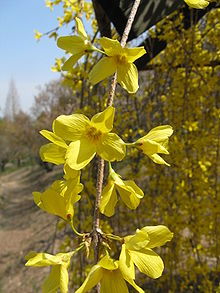Pendent forsythia
| Pendent forsythia | ||||||||||||
|---|---|---|---|---|---|---|---|---|---|---|---|---|

Hanging forsythia ( Forsythia suspensa ) |
||||||||||||
| Systematics | ||||||||||||
|
||||||||||||
| Scientific name | ||||||||||||
| Forsythia suspensa | ||||||||||||
| ( Thunb. ) Vahl |
The forsythia suspensa ( Forsythia suspensa ) is a golden yellow flowering shrub from the family of Olive Family (Oleaceae). The natural range of the species is in the temperate zone of China. It is very often used as an ornamental shrub .
description
The hanging forsythia grows as an upright to strongly overhanging shrub and reaches heights of 1 to 2 meters. The twigs are round and yellow-brown or gray-brown. The pith of the branches is chambered. The leaves are divided into a petiole and a leaf blade. The petiole is glabrous or sometimes downy and 8 to 15 millimeters long. The leaf blade is simple or rarely three-lobed or three-leaved. It is 2 to 10 centimeters long, 1.5 to 5 centimeters wide, egg-shaped, broadly egg-shaped or oval-egg-shaped, pointed with a rounded or wedge-shaped base and sawn leaf edge. Both sides are bald or rarely downy, the underside can be shaggy, especially along the leaf veins.
The flowers stand individually, in pairs or several in the leaf axils on 5 to 6 millimeter long stems. The calyx is about 2.5 centimeters long, with elongated, rarely 5, usually 6 to 7 millimeters long and ciliate calyx tips. The corolla is yellow and the corolla tube is shorter or about the same length as the calyx tips. The corolla lobes are 7 to 15 millimeters long, oblong or obovate oblong. The pistil is 5 to 7 millimeters long in flowers with 3 to 5 millimeter long stamens , about 3 millimeters long in flowers with 6 to 7 millimeter long stamens. The capsule fruit is 12 to 25 millimeters long and 6 to 12 millimeters wide, ovoid to long ellipsoidal and covered with scattered cork pores . The hanging forsythia blooms from March to April, the fruits ripen from July to September.
The number of chromosomes is 2n = 28.
Occurrence
The natural range is in the temperate zone in the west of the Chinese province of Anhui , in Hebei , Henan , Hubei , Shaanxi , Shandong , Shanxi and Sichuan . It grows in steppes and dry forests at an altitude of 300 to 2200 meters on moderately dry to fresh, slightly acidic to alkaline, sandy-loamy to loamy, nutrient-rich soils in sunny to light-shaded locations. The species loves warmth and is usually frost hardy.
Systematics
The forsythia suspensa ( forsythia suspensa ) is a kind of the genus of forsythia ( Forsythia ) in the family of Oleaceae (Oleaceae). There it is assigned to the Forsythieae tribe . Peter Carl Thunberg has 1784 kind as Syringa suspensa ( Basionym ) first described , and the kind of the case Lilac ( Syringa ) is assigned. Vahl placed the species in the genus of forsythia in 1804. The generic name Forsythia is reminiscent of the English botanist William Forsyth , the specific epithet suspensa comes from Latin, means "hanging" and refers to the hanging branches.
Some authors distinguish three varieties :
- Forsythia suspensa var. Suspensa
- Forsythia suspensa var. Fortunei (Lindl.) Rehder
- Forsythia suspensa var. Sieboldii Zabel
However, these are usually not recognized.
use
The hanging forsythia is very often planted as an ornamental shrub because of its decorative flowers . The fruits are used in China against fever and symptoms of poisoning.
A distinction is made between different cultivars , including:
- 'Decipiens' with mostly solitary, deep yellow and long-styled flowers.
proof
literature
- Wu Zheng-yi, Peter H. Raven (Ed.): Flora of China . Volume 15: Myrsinaceae through Loganiaceae . Science Press / Missouri Botanical Garden Press, Beijing / St. Louis 1996, ISBN 0-915279-37-1 , pp. 279 (English).
- Andreas Roloff , Andreas Bärtels: Flora of the woods. Purpose, properties and use. With a winter key from Bernd Schulz. 3rd, corrected edition. Eugen Ulmer, Stuttgart (Hohenheim) 2008, ISBN 978-3-8001-5614-6 , p. 301.
- Jost Fitschen: Woody flora . 12th, revised and expanded edition. Quelle & Meyer, Wiebelsheim 2007, ISBN 3-494-01422-1 , p. 494-495 .
- Helmut Genaust: Etymological dictionary of botanical plant names. 3rd, completely revised and expanded edition. Nikol, Hamburg 2005, ISBN 3-937872-16-7 (reprint from 1996).
Individual evidence
- ↑ German name after Roloff et al .: Flora der Gehölze , p. 301 and Fitschen: Gehölzflora , p. 495
- ↑ a b c d e Mei-chen Chang, Lien-ching Chiu, Zhi Wei, Peter S. Green: Forsythia suspensa . In: Wu Zheng-yi, Peter H. Raven (Ed.): Flora of China . Volume 15: Myrsinaceae through Loganiaceae . Science Press / Missouri Botanical Garden Press, Beijing / St. Louis 1996, ISBN 0-915279-37-1 , pp. 279 (English).
- ↑ a b c d e Roloff et al .: Flora der Gehölze , p. 301
- ^ Erich Oberdorfer : Plant-sociological excursion flora for Germany and neighboring areas . With the collaboration of Angelika Schwabe and Theo Müller. 8th, heavily revised and expanded edition. Eugen Ulmer, Stuttgart (Hohenheim) 2001, ISBN 3-8001-3131-5 , pp. 749 .
- ↑ a b Forsythia suspensa. In: Germplasm Resources Information Network (GRIN). United States Department of Agriculture, accessed April 6, 2012 .
- ↑ Syringa suspensa. In: Germplasm Resources Information Network (GRIN). United States Department of Agriculture, accessed April 6, 2012 .
- ↑ Exactly: Etymological Dictionary of Botanical Plant Names , p. 254
- ↑ Exactly: Etymological Dictionary of Botanical Plant Names , p. 622
- ↑ a b Fitschen: Gehölzflora , p. 495
- ↑ Forsythia suspensa. In: The Plant List. Retrieved April 6, 2012 .

